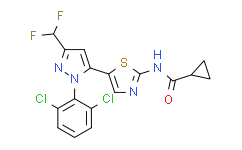| Cas No.: | 1338247-30-5 |
| Chemical Name: | BMS-3 |
| Synonyms: | BMS-3;N-[5-[2-(2,6-dichlorophenyl)-5-(difluoromethyl)pyrazol-3-yl]-1,3-thiazol-2-yl]cyclopropanecarboxamide;BMS3;N-[5-[1-(2,6-Dichlorophenyl)-3-(difluoromethyl)-1H-pyrazol-5-yl]-2-thiazolyl]-cyclopropanecarboxamide;N-(5-(1-(2,6-dichlorophenyl)-3-(difluoromethyl)-1H-pyrazol-5-yl)thiazol-2-yl)cyclopropanecarboxamide;C17H12Cl2F2N4OS;SYN1023;BCP17224;AK547235 |
| SMILES: | ClC1C([H])=C([H])C([H])=C(C=1N1C(=C([H])C(C([H])(F)F)=N1)C1=C([H])N=C(N([H])C(C2([H])C([H])([H])C2([H])[H])=O)S1)Cl |
| Formula: | C17H12Cl2F2N4Os |
| M.Wt: | 429.2712 |
| Sotrage: | 2 years -20°C Powder, 2 weeks 4°C in DMSO, 6 months -80°C in DMSO |
| Description: | BMS-3 is a potent LIMK inhibitor with IC50s of 5 nM and 6 nM for LIMK1 and LIMK2, respectively. |
| In Vitro: | BMS-3 (Compound 2) causes a dose-dependent reduction in cell count and induces mitotic arrest by increases in total nuclear DNA intensity and histone H3 phosphorylation after 24 h treatment in A549 human lung cancer cells. BMS-3 inhibits A549 human lung cancer cells with EC50 value of 154 nM[1]. BMS-3 is used to demonstrate the direct participation of LIMK1 in the phosphorylation of Cofilin. Inhibition of p-LIMK with 1-50 μM of BMS-3 results in a dose-dependent decrease of p-Cofilin after 10 min incubation in capacitating conditions. As a control, sperm are also incubated for 10 min under non-capacitating conditions which result in low levels of p-Cofilin. In the presence of 1 or 50 μM of BMS-3, actin polymerization levels are significantly lower compared to controls (DMSO). Mouse sperm are incubated under capacitating conditions for 90 min in the presence or absence of increasing concentrations of p-LIMK inhibitor BMS-3 (0, 1, 10 and 50 μM). The increasing concentrations of BMS-3 result in a strong decrease on the percentage of sperm that undergoes acrosomal exocytosis after stimulation with 20 μM of Progesterone[2]. |






















